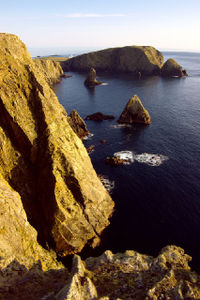Fair Isle
2007 Schools Wikipedia Selection. Related subjects: European Geography
Fair Isle (from Old Norse Frjóey) is an island off Scotland, lying around halfway between Shetland and the Orkney Islands at . Three miles (4.8 km) in length and 1.5 miles (2.4 km) wide, it has an area of 1402 acres (2.2 square miles or 5.61 km²). The island is situated around 25 miles (40 km) south-west of Sumburgh Head on the Shetland mainland. Although it is marginally closer to North Ronaldsay Orkney, Fair Isle is administratively part of Shetland. It gives its name to one of the British Sea Areas.
The majority of the 70 islanders live in the crofts on the southern half of the island, with the northern half consisting of rocky moorland. The western coast consists of cliffs of up to 660 feet (200 m) in height. The population has been decreasing steadily from around 400 in around 1900. There are no pubs or restaurants on the island, but there is a single primary school. After the age of 11, children must attend a boarding school in Lerwick.
Fair Isle has been occupied since the Bronze Age which is remarkable because of the lack of raw materials on the island, although it is surrounded by rich fishing waters. It has a permanent bird observatory because of its importance as a bird migration watchpoint and this provides most of the accommodation on the island. It is unusual amongst bird observatories in providing catered accommodation rather than hostel-style. Many rare species of bird have been found on the island, and it is probably the best place in western Europe to see skulking Siberian passerines like Pechora Pipit, Lanceolated Warbler and Pallas's Grasshopper Warbler.
The island was bought by the National Trust for Scotland in 1954 from George Waterson, the founder of the bird observatory.
Fair Isle is famous for its knitted jumpers, with knitting forming an important source of income for the women of the islands. The principal activity for the male islanders is crofting.
Ward Hill (715ft) played host to a hastily built RAF radar station during WWII, the ruins of which are still present today. There are also substantial sections of a crashed Heinkel He111.
On August 20, 1588 the flagship of the Spanish Armada, El Gran Grifón, was shipwrecked in the cove of Stroms Heelor, forcing its 300 sailors to spend six weeks living with the islanders. The wreck was discovered in 1970.
On January 29, 2004, Fair Isle was granted Fairtrade Island status.
Transport
- Fair Isle Airport serves the island with flights to Lerwick
- The Good Shepherd IV plies between Fair Isle and Grutness

